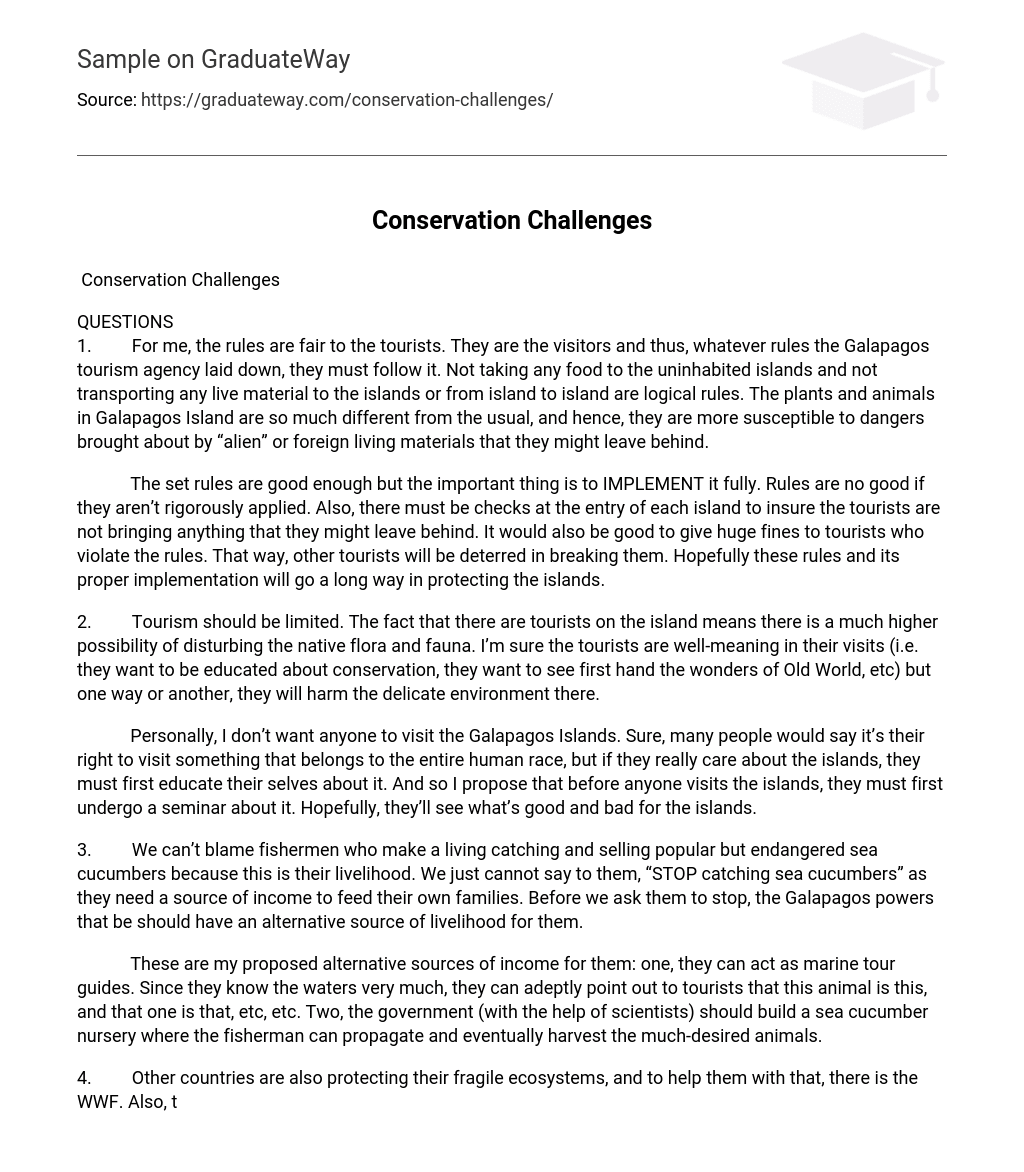QUESTIONS
1. For me, the rules are fair to the tourists. They are the visitors and thus, whatever rules the Galapagos tourism agency laid down, they must follow it. Not taking any food to the uninhabited islands and not transporting any live material to the islands or from island to island are logical rules. The plants and animals in Galapagos Island are so much different from the usual, and hence, they are more susceptible to dangers brought about by “alien” or foreign living materials that they might leave behind.
The set rules are good enough but the important thing is to IMPLEMENT it fully. Rules are no good if they aren’t rigorously applied. Also, there must be checks at the entry of each island to insure the tourists are not bringing anything that they might leave behind. It would also be good to give huge fines to tourists who violate the rules. That way, other tourists will be deterred in breaking them. Hopefully these rules and its proper implementation will go a long way in protecting the islands.
2. Tourism should be limited. The fact that there are tourists on the island means there is a much higher possibility of disturbing the native flora and fauna. I’m sure the tourists are well-meaning in their visits (i.e. they want to be educated about conservation, they want to see first hand the wonders of Old World, etc) but one way or another, they will harm the delicate environment there.
Personally, I don’t want anyone to visit the Galapagos Islands. Sure, many people would say it’s their right to visit something that belongs to the entire human race, but if they really care about the islands, they must first educate their selves about it. And so I propose that before anyone visits the islands, they must first undergo a seminar about it. Hopefully, they’ll see what’s good and bad for the islands.
3. We can’t blame fishermen who make a living catching and selling popular but endangered sea cucumbers because this is their livelihood. We just cannot say to them, “STOP catching sea cucumbers” as they need a source of income to feed their own families. Before we ask them to stop, the Galapagos powers that be should have an alternative source of livelihood for them.
These are my proposed alternative sources of income for them: one, they can act as marine tour guides. Since they know the waters very much, they can adeptly point out to tourists that this animal is this, and that one is that, etc, etc. Two, the government (with the help of scientists) should build a sea cucumber nursery where the fisherman can propagate and eventually harvest the much-desired animals.
4. Other countries are also protecting their fragile ecosystems, and to help them with that, there is the WWF. Also, the UN itself has a list of Protected Areas. In the United States, Yellowstone National Park is one of the oldest to be established as such. By 2003, there are already 102,102 listed protected sites that cover 18.8 million km2 of area. And 17 million km2 of that is terrestrial, about 11.5% of the Earth’s land surface. That’s good enough, I guess! =)
In the Philippines, I heard that their tallest mountain, Mt. Apo and its surrounding National Park is currently off-limits to the public. This was done to protect the land which has been maltreated by climbers, reducing the majestic Philippine Eagle’s habitat. Scientists and other serious climbers who want to visit Mt. Apo must get a special permission first before they can visit the protected areas.
DISCUSSION
Our world is full of wonderful places where you can observe nature and all its processes in its wildest glory. Unfortunately, because of modern humans (and their territorial activities), these regions are being reduced in terms of area and their unique flora and fauna are slowly being depleted. True, what is happening in Galapagos Islands right now is similar to what is happening in other wild oceanic islands. If we want the future generations to enjoy these places, we must act now to protect these areas. We only have one world, we don’t want it to die like the already extinct species.
Thus, if you are lucky enough to visit Galapagos and other natural wonders, take great care to “take only pictures and leave only footprints”. This means that, as much as possible, do NOT disturb the flora and fauna there. Don’t uproot plants to bring home, don’t catch animals for souvenirs, and don’t leave things/animals that came from your world. Be satisfied with pictures as a souvenir of your trip. And you don’t have to leave anything (except footprints) to tell the next visitors that {insert name here} has conquered this place!





